There are twelve species of turtles in Ohio that are endmic to the state. They include a variety of types such as painted turtles, box turtles, map turtles, softshell turtles and more.
Most of these are aquatic or semi-aquatic and spend most of their time in an aquatic environment. The only exception is the eastern box turtle which spends most of its time on land.
Turtles In Ohio
1. Midland Painted Turtle
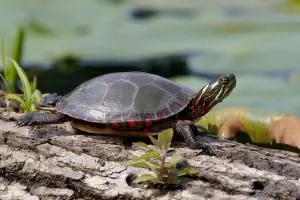
- Experience Level: Beginner
- Family: Emydidae
- Scientific Name: Chrysemys picta marginata
- Adult Size: 4 to 10 inches
- Lifespan: 30 to 40 years
- Average Price Range: $20 to $40
- Where to buy: Backwater Reptiles.
- Recommended Books: Painted Turtle Pet Owners Guide by Ben Team
C. p. marginata or the midland painted turtle is a subspecies of the painted turtle (Chrysemys picta). The subspecies of Chrysemys picta are determined based on their geographical range. Midland Turtles are a small to medium size turtle with carapace lengths of 4 to 10 inches.
Males are generally smaller and generall only reach lengths of about 5 inches. Females on the other hand range from 9-10 inches. Their carapace is slightly doomed and smooth and don’t really have any ridges. Additionally, their carapace is olive green to black with red spots on the marginal scutes.
The midland painted turtle can generally be found in Ohio, Indiana, Wisconsin, Iowa, Michigan, and Illinois.
Since this subspecies is commonly bred, they can be found from several reputable captive breeders.
2. Red-Eared Slider
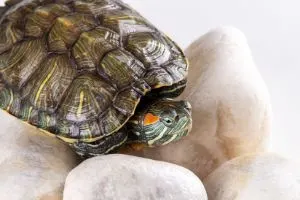
- Experience Level: Beginner
- Family: Emydidae
- Scientific Name: Trachemys scripta elegans
- Adult Size: 6 to 12 inches
- Lifespan: 20 to 40 years
- Average Price Range: $20 to $50
The red-eared slider is a hardy and gentle turtle, though they can still bite you.
They are a popular beginner turtle mostly because of their sheer availability. They are also relatively easy to care for so long as their setup is correct.
Since they are easy to care for and can thrive in a wide range of ecosystems they have become an invasive species since some pet owners release them into geographical ranges where they weren’t endemic.
The red-eared slider is so-called because of the red streaks on both ears. T. s. elegans grows to about 6 to 12 inches and a lifespan of 20 to 40 years.
3. Spotted turtle
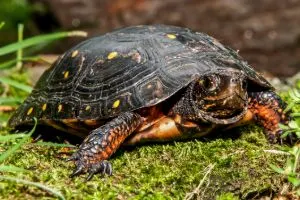
- Experience Level: Intermediate
- Family: Emydidae
- Scientific Name: Clemmys guttata
- Adult Size: 3.5 to 4.5 inches
- Lifespan: 25 years
- Average Price Range: $75 to $100 (hatchlings), $250 to $300 (subadults/adults)
- Recommended Books: BASICS – Ecology, Husbandry & Breeding Spotted & Wood Turtles by Andreas S. Hennig
The Spotted turtle is a small turtle with yellow spots on its black carapace. As you may have already guessed, these yellow spots give it its common name. The have a flattened shell and yellowish-orange limbs, neck, and head.
This hardy and friendly turtle is low maintenance and requires very little space which also makes them them an excellent first pet turtle.
Since they are quite uncommon, they can be more expensive, but still aren’t too high when comparing to some species. A hatchling can cost you $100 and subadults can cost you upwards of $250.
C. guttata is listed as a vulnerable species on the IUCN Red List.
4. Wood turtle

- Experience Level: Intermediate
- Family: Emydidae
- Scientific Name: Glyptemys [Clemmys] insculpta
- Adult Size: 6.3 to 9.8 inches
- Average Lifespan: 12.5 years
- Average Price Range: $300 (subadults/adults)
- Where to buy: The Turtle Source, Fresh Marine
- Recommended Books: BASICS – Ecology, Husbandry & Breeding Spotted & Wood Turtles by Andreas S. Hennig
Wood Turtles are an endangered turtle species closely related to C. guttata (spotted turtle). In fact, both turtles used to belong to the same genus – Clemmys.
The North American wood turtle is usually found in forests and grasslands. Although they don’t spend a lot of time in the water, they are rarely ever found far from flowing water.
These endangered turtles are quite rare and expensive to acquire. For a captive bred specimen you can expect to pay around $300.
5. Eastern Box Turtle
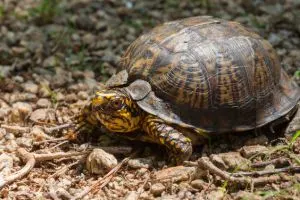
- Experience Level: Beginner
- Family: Emydidae
- Scientific Name: Terrapene carolina carolina
- Adult Size: 4.33 to 7 inches
- Lifespan: 40 years
- Average Price Range: $120 to $400
- Recommended Books: Box Turtles (Complete Herp Care) by Tess Cook
The Eastern box turtle is probably the most popular box turtle in North America. No wonder, it is also called the common box turtle. This species is endemic to the eastern US.
As you may have guessed, the geographical range of this turtle gives it its common name – eastern box turtle.
The carapace of this chelonian is black/brown with yellow spots, streaks, and lines. As a box turtle, T. c. carolina is highly domed and is mostly terrestrial.
T. c. carolina is widely bred and can be purchased from many reputable breeders.
6. Blanding Turtle
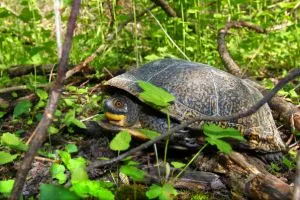
- Experience Level: Intermediate to Advanced
- Family: Emydidae
- Scientific Name: Emydoidea [Emys] blandingii
- Adult Size: 7.1 to 9.1 inches
- Lifespan: 77 years
- Average Price Range: $350 to $450
The endangered Blandings turtle is endemic to eastern and central United States and Canada, and this includes Ohio.
This is a medium-sized turtle with a black carapace that has several yellow streaks and a bright yellow chin and throat.
Adults have high domes and their carapaces lack keels and sculpturing. Similar to other turtles on this list (these include wood turtle and spotted turtle), E. blandingii is a semi-aquatic species.
Captive breeding is rare and recent. As such, the prices of captive-bred individuals are quite high. Also, little is known about their lifespan in captivity. However, in the wild, they have a minimum lifespan of about 70 years.
7. Common Map Turtle
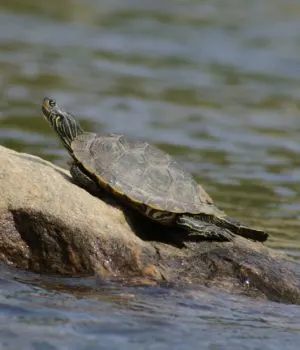
- Experience Level: Beginner
- Family: Emydidae
- Scientific Name: Graptemys geographica
- Adult Size: 3.5 to 10 inches
- Lifespan: 20 years
- Average Price Range: $30 to $100
- Where to buy: Fresh Marine, and The Turtle Source
- Recommended Books: Aquatic Turtles: Sliders, Cooters, Painted, and Map Turtles (Reptile Keeper’s Guide) by R.D. Bartlett and Patricia Bartlett
The G. geographica also known as the northern map turtle is found in the northern part of the United States which includes Ohio.
As with other map turtles, the G. geographica has contour-like patterns on the shell and skin resembling a map. This is why these chelonians are called map turtles.
As with other map turtles, the males are much smaller than females. While an adult male grows to 3.5 to 6.5 inches, adult females grow to 7 to 10 inches in carapace length.
8. Ouachita Map Turtle
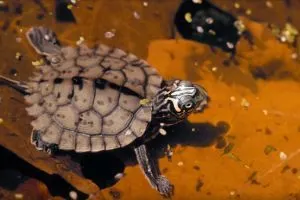
- Experience Level: Beginner
- Family: Emydidae
- Scientific Name: Graptemys ouachitensis
- Adult Size: 5 to 10 inches
- Lifespan: 20 years
- Average Price Range: $30 to $100
- Where to buy: Underground Reptiles, Fresh Marine, and The Turtle Source
- Recommended Books: Aquatic Turtles: Sliders, Cooters, Painted, and Map Turtles (Reptile Keeper’s Guide) by R.D. Bartlett and Patricia Bartlett
The Ouachita map turtle is a small to medium-sized turtle with a prominent ridge that goes down its carapace. As with other map turtles, G. ouachitensis has a series of yellow connected lines that resembles the contours of a map.
The plastron is plain yellow. This chelonian looks very much like the common map turtle.
The easiest way to tell them apart is by looking at the spots behind the eyes. G. ouachitensis has large yellow spots behind the eyes which extends to the top of the head. In contrast, the common map turtle has small yellow spots behind the eyes.
As with all other map turtles, the males are much smaller than the females. Females grow to lengths of 10 inches, while males grow to sizes of just 5 inches.
9. Common Snapping Turtle
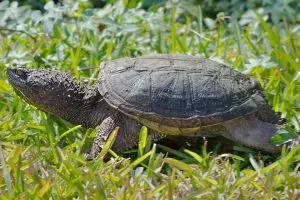
- Experience Level: Intermediate
- Family: Chelydridae
- Scientific Name: Chelydra serpentina
- Adult Size: 8 to 18 inches
- Lifespan: 50 years
- Average Price Range: $30 to $60
- Recommended Book: Snapping Turtle Pet Owners Guide by Ben Team
The Common snapping turtle is another one of the turtles native to Ohio. These chelonians are rugged-looking turtles with long tails. Their carapace is tan/brown, and they have tubercles (wart-like projection) on their neck and limbs.
This turtle is relatively easy to care for although they require a lot of space.
As with most turtles they are display pets and snappers are particularly aggressive turtles.
They would be best kept in a large outdoor pond setup.
10. Common Musk Turtle
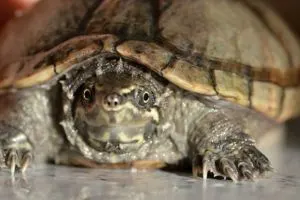
- Experience Level: Intermediate
- Family: Kinosternidae
- Scientific Name: Sternotherus odoratus
- Adult Size: 3 to 5 inches
- Lifespan: 50 years
- Average Price Range: $6 to $50
The Common Musk turtle is also known as the stinkpot as they release a foul-smelling odor when scared or stressed. They are native to the United States, and in particular the eastern United States.
These chelonians are some of the smaller turtles and generally low maintenance. They can be quite aggressive and their tanks need to be kept very clean.
In the wild, they prefer shallow waters that include lakes, rivers, ponds, and streams. They usually grow to be anywhere from just 3 to 5 inches.
Appearance wise they have a smooth high-domed carapace that is black and or brown.
Their skin is also dark in coloration. You can identify this species by the barbels on their chin and the underside of their neck.
11. Eastern Spiny Softshell Turtle
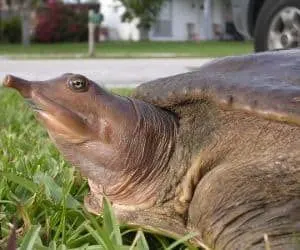
- Experience Level: Intermediate
- Family: Trionychidae
- Scientific Name: Apalone spinifera spinifera
- Adult Size: 3 to 5 inches
- Lifespan: 50 years
- Average Price Range: $80 to $140
- Recommended Books: Softshell Turtle Pet Owners Guide by Ben Team
The Eastern spiny softshell is quite large, especially the females. While the males grow to lengths of 5 to 9 inches, females grow a bit more ranging from 7 to 17 inches.
Like all softshell turtles, the A. s. Spinifera has a leathery shell instead of the hard shells of most other turtles. While they may have a soft shell they do have strong jaws and sharp claws so are still able to protect themselves.
Males have olive and or tan carapaces with tiny black spots and circles while females have much darker shells with gray and brown blotches.
These are also some of the faster turtle species out there.
12. Midland Smooth Softshell Turtle
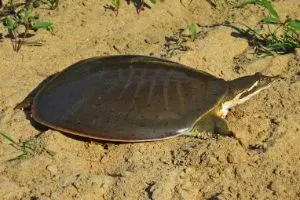
- Experience Level: Intermediate
- Family: Trionychidae
- Scientific Name: Apalone mutica mutica
- Adult Size: 3 to 5 inches
- Lifespan: 50 years
- Average Price Range: $30
- Recommended Books: Softshell Turtle Pet Owners Guide by Ben Team
Midland softshells are moderately large and can reach lengths of 4 to 7 inches for adult males and 6 to 14 inches for adult females. As with other turtles from the genus -Apalone, males are generally smaller.
Their carapace’s color is dependent on their gender and age. Males and juveniles will have brown and or olive-gray carapaces with faint dots and marks while females have more of a smear or blotchy design of brown, and or olive.
Unlike the spiny softshell, the smooth softshell lacks the spines and bumps found around the front edge of their carapaces.
Conclusion
These are the twelve turtles in Ohio that are originally from the state. There was a wide range of types including Painted Turtles, Snapping Turtles, Map Turtles, Musk Turtles, Softshell Turtles, Pond Sliders, Wood Turtles and Box turtles too.
If you are looking for a pet turtle, we highly recommend doing your research and taking into account that turtles live a long time and require a well maintained environment.
You should never catch a turtle and make sure you only buy from a captive bred breeder. Pet stores many times will have wild caught animals which is damaging to our ecosystem and the animals conservation.
I hope this has been informative for you and if you have any comments or questions, please leave them below.
Other nearby states
- Turtles in Indiana
- Turtles in Kentucky
- Turtles in Michigan
- Turtles in Pennsylvania
- Turtles in West Virginia

C wren
Wednesday 22nd of September 2021
I found a baby turtle in our salt water pool filter today. His shell was about the size of a half dollar and dark colored. I did not notice any color on the turtle but on the outskirts of its shell it had a perfect row of intermittent black and white all around the shell. It was so precise like you would see around the top of a basket. I was unsure what to do with the turtle because our pool is heated and I worried it would die. So we ended up putting it on the rim of our small pond which is very far from the pool. I can't seem to find pic to match this little guy. Wish I had taken pic. Any ideas what kind of turtle is was and did I do right thing putting in near pond. Lots of frogs and fish in the pond.